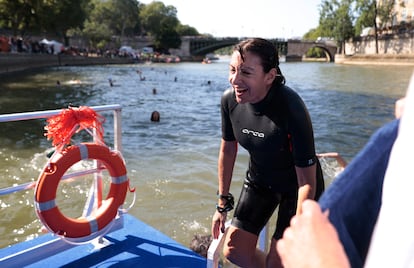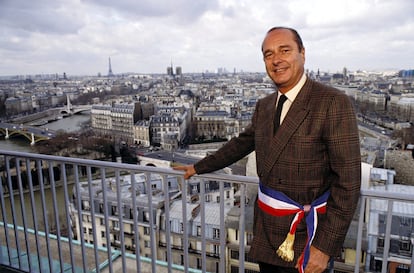Swimming in the Seine again: A brief history of a French obsession
The mayor of Paris, Anne Hidalgo, plunged into the river in a highly publicized event meant to show that the water is ready for the Olympic Games. But there is more to it than that, and a long history of failures

Anne Hidalgo emerged from the waters on Wednesday wrapped in neoprene and wearing her best smile, looking like a cross between a naiad and an extra from Point Break. “Look at the happiness around you,” she declared before the cameras. “We have been dreaming about this for years.” The mayor of Paris had just plunged into the Seine, where swimming was prohibited a century ago. Her prominent display of front crawl announced a new era for the French capital’s relationship with its famous river. Several swimming competitions for the Olympic Games, which begin on July 26, will be held in the Seine. Starting in 2025, any Parisian will be able to go swimming at four points along the river as it passes through the city.
It was the kind of photo that makes history. The mayor was aiming to contradict the rumors that, in recent weeks, suggested that the low water quality would make it difficult to hold open swimming events. All this, in the midst of countless news articles (2,400 in total, according to a count by the weekly Le Point) that predicted a municipal debacle, pointed to the presence of bacteria, an inevitable synonym of fecal matter, and the risk of contracting leptospirosis, a disease caused by rat urine. Hidalgo could not afford to lose this bet: she had made cleaning up the river a cornerstone of her program. “We will clean up the Seine for the Games, but above all we will contribute to not damaging the oceans, to which cleaner water will flow,” she said on Wednesday. The city’s strategy has been to frame the sanitation plan not only in the context of the Olympic Games. It was not just about getting a nice Olympic postcard picture, but about “returning the Seine to the citizens.”
Until the 20th century, Parisians maintained a very close, almost carnal relationship with the Seine. Everything changed with the construction of stone shores and the arrival of the automobile to its docksValérie Kozlowski, Carnavalet Museum
There was another, subtler message between the lines: Hidalgo was making a dream come true, catering to a Parisian and also a broader French obsession. The Seine is, clearly, much more than a river. Built around it, Paris cannot be understood without its waterway, which slices the city into two halves and governs its geography, dividing it between the rive gauche, or left bank, south of the Seine; and the rive droite or right bank, north of the river. Not by chance, until 1968, the département of Paris was simply called Seine. “The river has been a fundamental element in the history of the city. Above all, in terms of logistics, because it was the great artery through which most transport and merchandise arrived, as it was the main route of navigation and entry point of wealth. In addition, there is a spiritual dimension to it: the inhabitants of ancient Lutetia venerated the river goddess Sequana since ancient times,” says Valérie Kozlowski, curator of the archaeological collections at the Carnavalet Museum, which tells the history of Paris.
Since the times of the Roman Empire, the Seine was a source of pure and abundant water. With urban development, the river became a dumping ground for human and industrial waste. Over the centuries, several initiatives sought to improve water quality, including the construction of a canal in 1808 and a new drinking water and sewage network in the 19th century, although nothing managed to mitigate pollution. “Until the 20th century, Parisians maintained a very close, almost carnal relationship with the Seine, but everything changed with the construction of stone banks and the arrival of the automobile to its docks. Little by little, this urbanization and modernization distanced Parisians from their river,” adds Kozlowski. In recent decades, the pedestrianization of the banks of the Seine was a turning point. The possibility of submerging in its waters is another step forward, although critical voices warn that “an ecosystem cannot be transformed with a magic wand, even if it is an Olympic one,” as the online newspaper Mediapart put it on Wednesday, denouncing that the storytelling effort of the municipal team could come to nothing.

Until the 19th century, it was common to swim in the river, as Georges Seurat and Honoré Daumier immortalized in their paintings. In 1923, swimming in the Seine was prohibited, although many citizens flouted the new rule, as demonstrated by the old photographs by Robert Doisneau on the Iéna bridge. This was the case until the 1950s, when swimming was discontinued due to the danger posed by currents and river traffic, to which were later added chemical and bacterial contamination. As early as the 1920s, doctors were already advising people to wash with running water after exposing themselves to the Seine, and to “close your mouth while swimming.”
Hidalgo has made true the dream of Jacques Chirac while he was mayor of the capital. In the late 1980s, he promised that he would swim in the river before finishing his term to show that it was no longer contaminated, in a gesture of environmental willpower that led nowhere. Despite promoting the cleanup of the Seine, in 1990 he was forced to admit that he could not keep his promise.
In June 2017, the city organized an exhibition of 36 Olympic sports from the Pont Alexander III bridge, in a spectacular operation to seduce the International Olympic Committee, with Hidalgo on a kayak, but without getting into the water. The water competitions would be held, they promised then, in that highly polluted river. The power of that image, with the Eiffel Tower as a unique backdrop, trumped all other candidates to host the Games. The challenge became to clean up the river in record time, with the fear that the promise would remain unfulfilled, as happened to Chirac decades ago.

After various setbacks and a battle against political enemies who turned her into their bête noire, Hidalgo won the war of images. “The entire sequence is framed as spectacle politics. These types of symbols are deeply rooted in our political culture, as all our presidents have demonstrated, from François Mitterrand to Emmanuel Macron, who turned their oath-taking ceremonies into theatrical stagings,” says Jean Garrigues, a historian of French politics and professor emeritus of the University of Orléans.
“In France these symbolic gestures are very important, although they are less common in other European countries. The important thing in terms of environmental policy should be reducing the carbon footprint and erecting buildings adapted to climate change, but we prefer symbols and images.” That, too, has been a source of ridicule: before Hidalgo, on Saturday, Sports Minister Amélie Oudéa-Castéra went swimming in the Seine. The moment was turned into countless memes where the minister morphed into a mutant being or developed infectious pimples all over her body.
Next in line for a dip in the river should be Emmanuel Macron, who in April promised that he would also take the plunge before the Games open. For now, no date has been announced.
Sign up for our weekly newsletter to get more English-language news coverage from EL PAÍS USA Edition
Tu suscripción se está usando en otro dispositivo
¿Quieres añadir otro usuario a tu suscripción?
Si continúas leyendo en este dispositivo, no se podrá leer en el otro.
FlechaTu suscripción se está usando en otro dispositivo y solo puedes acceder a EL PAÍS desde un dispositivo a la vez.
Si quieres compartir tu cuenta, cambia tu suscripción a la modalidad Premium, así podrás añadir otro usuario. Cada uno accederá con su propia cuenta de email, lo que os permitirá personalizar vuestra experiencia en EL PAÍS.
¿Tienes una suscripción de empresa? Accede aquí para contratar más cuentas.
En el caso de no saber quién está usando tu cuenta, te recomendamos cambiar tu contraseña aquí.
Si decides continuar compartiendo tu cuenta, este mensaje se mostrará en tu dispositivo y en el de la otra persona que está usando tu cuenta de forma indefinida, afectando a tu experiencia de lectura. Puedes consultar aquí los términos y condiciones de la suscripción digital.
More information
Archived In
Últimas noticias
There is as much life left to discover on planet Earth as that which is already known
Dozens presumed dead, around 100 injured in fire at Swiss Alps bar during New Year’s celebration
Is porn for women different from conventional porn? We spoke to those who make it
Cartagena de Indias is sinking: What can the city do to mitigate it?
Most viewed
- Reinhard Genzel, Nobel laureate in physics: ‘One-minute videos will never give you the truth’
- Sinaloa Cartel war is taking its toll on Los Chapitos
- David King, chemist: ‘There are scientists studying how to cool the planet; nobody should stop these experiments from happening’
- Oona Chaplin: ‘I told James Cameron that I was living in a treehouse and starting a permaculture project with a friend’
- The Interoceanic Train, the Mexican alternative to the Panama Canal










































